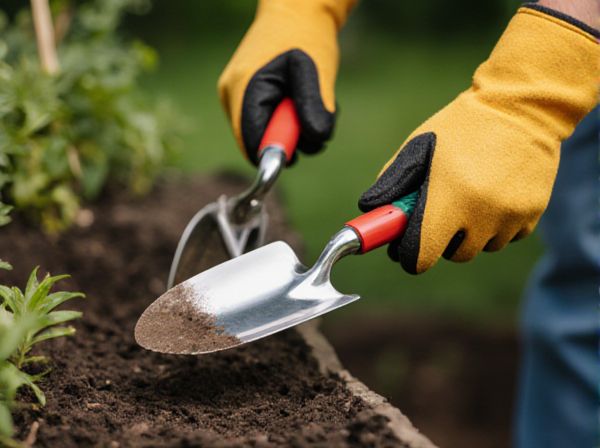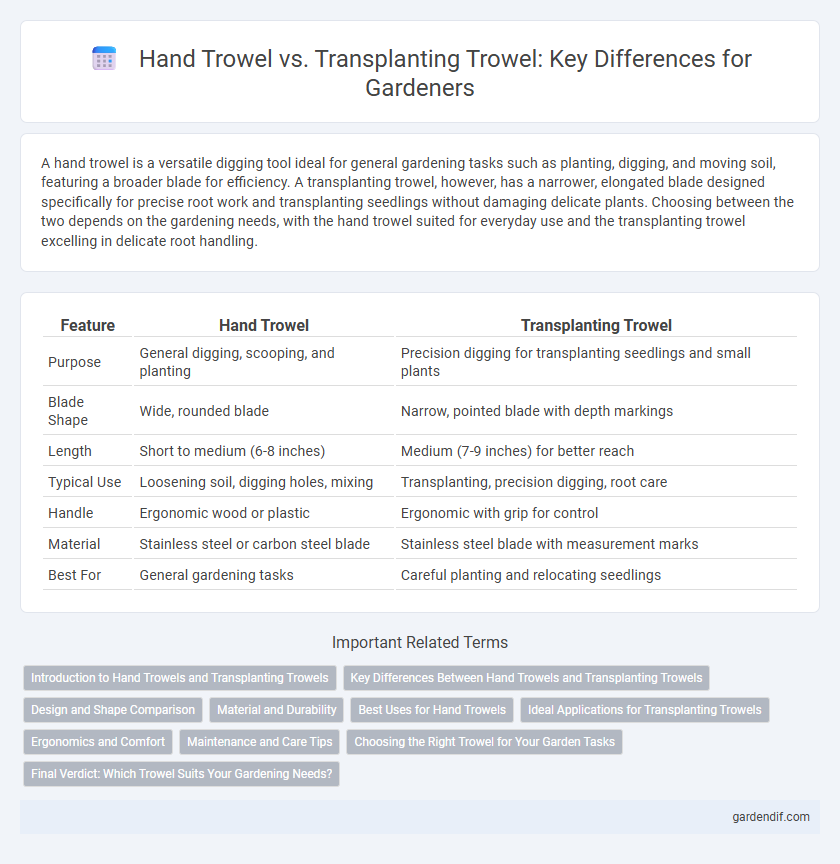
Hand trowel vs transplanting trowel Illustration
A hand trowel is a versatile digging tool ideal for general gardening tasks such as planting, digging, and moving soil, featuring a broader blade for efficiency. A transplanting trowel, however, has a narrower, elongated blade designed specifically for precise root work and transplanting seedlings without damaging delicate plants. Choosing between the two depends on the gardening needs, with the hand trowel suited for everyday use and the transplanting trowel excelling in delicate root handling.
Table of Comparison
| Feature | Hand Trowel | Transplanting Trowel |
|---|---|---|
| Purpose | General digging, scooping, and planting | Precision digging for transplanting seedlings and small plants |
| Blade Shape | Wide, rounded blade | Narrow, pointed blade with depth markings |
| Length | Short to medium (6-8 inches) | Medium (7-9 inches) for better reach |
| Typical Use | Loosening soil, digging holes, mixing | Transplanting, precision digging, root care |
| Handle | Ergonomic wood or plastic | Ergonomic with grip for control |
| Material | Stainless steel or carbon steel blade | Stainless steel blade with measurement marks |
| Best For | General gardening tasks | Careful planting and relocating seedlings |
Introduction to Hand Trowels and Transplanting Trowels
Hand trowels and transplanting trowels are essential gardening tools designed for soil manipulation and plant care. Hand trowels feature a broader, sturdier blade ideal for digging, planting, and weeding in varied soil types, while transplanting trowels have narrower, elongated blades specifically crafted for precise transplanting and minimal root disturbance. The ergonomic design and blade shape of each trowel optimize efficiency and care in gardening tasks, catering to different horticultural needs.
Key Differences Between Hand Trowels and Transplanting Trowels
Hand trowels typically feature a broader, sturdier blade designed for general digging, planting, and soil mixing, while transplanting trowels have narrower, longer blades with depth markings for precise root handling and delicate plant transfers. The ergonomic handles of transplanting trowels often enhance control and reduce hand fatigue during detailed transplanting tasks. Material composition varies, with stainless steel blades preferred in transplanting trowels for rust resistance and durability compared to the often carbon steel blades of standard hand trowels.
Design and Shape Comparison
A hand trowel features a wider, flatter blade ideal for digging and scooping soil, with a pointed tip for precision in smaller gardening tasks. In contrast, a transplanting trowel has a narrower, elongated blade designed for carefully uprooting and replanting seedlings without damaging roots. The ergonomic handle designs on both tools improve grip and reduce hand fatigue, but the transplanting trowel's slim profile offers enhanced maneuverability in tight spaces.
Material and Durability
Hand trowels are typically made from stainless steel or carbon steel with wooden or plastic handles, providing a balance of durability and comfort for general gardening tasks. Transplanting trowels often feature narrower, tempered steel blades designed for precision and long-lasting strength to handle delicate plant roots without bending. Both tools are built to resist rust and corrosion, but transplanting trowels prioritize blade resilience to support repeated, careful soil penetration and root transfer.
Best Uses for Hand Trowels
Hand trowels excel in general gardening tasks such as digging small holes, mixing soil amendments, and planting annuals or perennials. Their curved, scoop-shaped blade allows for effortless soil manipulation, making them ideal for transplanting seedlings into beds or containers. Unlike transplanting trowels, which feature a narrower blade for precision, hand trowels offer versatility and ease of use for everyday garden maintenance.
Ideal Applications for Transplanting Trowels
Transplanting trowels are designed with narrow, elongated blades that facilitate precise digging in tight spaces, making them ideal for transplanting seedlings and small plants without disturbing nearby roots. Their pointed tips allow for efficient soil penetration and root separation, essential for delicate plant handling in gardening and horticulture. These trowels are preferred for tasks requiring accuracy and minimal soil disruption, such as moving young plants or dividing perennials.
Ergonomics and Comfort
Hand trowels and transplanting trowels differ significantly in ergonomics and comfort, with hand trowels featuring shorter, straighter handles designed for general digging tasks, emphasizing durability over user comfort. Transplanting trowels often have longer, narrower blades and ergonomically contoured handles with cushioned grips to reduce hand fatigue during precise planting and root handling. The ergonomic design of transplanting trowels supports prolonged use with better wrist alignment, making them ideal for delicate gardening tasks requiring comfort and control.
Maintenance and Care Tips
Proper maintenance of a hand trowel and transplanting trowel includes regular cleaning with water to remove soil and debris, preventing rust by drying thoroughly after each use, and occasional oiling of metal parts to ensure smooth operation. Sharpening the blade of a transplanting trowel maintains precision for delicate root work, while checking the handle for cracks and tightening any loose parts prolongs the tool's lifespan. Storing both tools in a dry, sheltered area protects them from environmental damage and promotes long-term functionality.
Choosing the Right Trowel for Your Garden Tasks
Hand trowels feature a wider, sturdier blade ideal for digging, planting, and soil loosening, while transplanting trowels have a narrower, elongated blade designed for precise root handling and transplanting seedlings. Selecting the right trowel depends on garden tasks: use hand trowels for general digging and planting, and transplanting trowels for delicate work with young plants to avoid root damage. Ergonomic handles and durable materials such as stainless steel enhance efficiency and comfort during prolonged garden work.
Final Verdict: Which Trowel Suits Your Gardening Needs?
A hand trowel is a versatile gardening tool ideal for general tasks such as digging, planting, and weeding, featuring a broader blade for scooping soil. In contrast, a transplanting trowel offers a narrower, elongated blade designed for precision in transplanting seedlings without disturbing roots. Choosing between the two depends on your gardening priorities: opt for a hand trowel for all-around use or a transplanting trowel for specialized seedling care and root-sensitive tasks.
Hand trowel vs transplanting trowel Infographic

 gardendif.com
gardendif.com